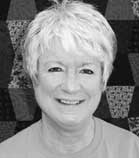 | Janeen Miller retired from Beech Aircraft in 2001. After a very brief retirement, she decided to turn one of her hobbies into a business. The Small Business Development Center at WSU gave guidance and encouragement in the development of a business plan; a perceptive bank executive listened to her presentation, reviewed the business plan and gave a ‘thumbs up’ to a start-up loan. Sunflower Quilts opened on September 9, 2002 with 500 bolts of fabric in a then too large space of 2500 square feet at 405 Osage Road in Derby Kansas.Today, the shop is in the same location, occupies just over 4000 square feet and has 5000 bolts of fabric. Husqvarna Viking sewing and embroidery machines were added in 2007. Owner’s classes and on-site service is offered for these machines.Customers are greeted by a friendly and knowledgeable staff and two Bichons, Louie and Mandy (they also appear in the TV commercials). The shop is filled with eye catching models, cabinets containing a rainbow of fabric bolts, walls of sewing notions, machine accessories and patterns. A large well-lit classroom displays class projects, finished quilts and embroidery projects. The atmosphere is relaxed – husband Jim likes to say “We offer fabric therapy – no appointment necessary.” Sunflower Quilts 405 Osage Rd Derby, KS 67037 (316)788-5120 www.SunflowerQuilts.com |
Arts & Crafts
2013-03-25 14:19:34
It's not your grandmother's quilt anymore
Q-My grandmother made a quilt for me when I was small. I would like to do the same for my grandchildren. I’ve done some sewing but have no idea where to start. What kind of quilt should I make?
A-Visit a local quilt shop – we are fortunate to have a number in the area that offer classes. Find something you like or think your grandchild will like and tell one of the store personnel what you would like to do and what your experience level is. They will be glad to offer assistance.
When your grandmother made a quilt she may have found the pattern in a newspaper, carefully cut out the pattern, transferred the pattern to a heavier piece of paper or cardboard, then carefully lay the pattern on her fabric and cut around the pattern with a pair of scissors. The quilt top may have been pieced (sewn together) on a treadle sewing machine and the final quilting was accomplished by stretching the top/batting/back on a quilting frame and quilting by hand. It was a common activity for visitors to sit at the quilting frame and join in with the hand quilting while catching up on the latest news/gossip of the day. Tieing the quilt sandwich together with yarn at intervals was/is an alternate way of finishing the quilt.
How times have changed. The introduction of the rotary cutter in the mid 1970s has allowed quilters to more rapidly cut the pieces to be quilted – even multiple layers of fabric at a time for the more experienced. A Myriad of rulers allow the quilter to make fast accurate cuts for the assembly of quilt blocks that were far too complex for grandma’s quilt.
Hundreds of different quilt patterns are available in quilt stores or online (fabric companies will offer free patterns using some of their fabric lines). There are even computer programs that will assist you in developing your very own quilt pattern.
The fabrics have also evolved. Quality cotton fabrics shrink or bleed color very little, if any, due to the processing they receive before being placed on the quilt store’s shelves. The colors are also more vibrant and varied
One recent innovation in fabric presentation is the ‘precut’. A typical precut, dubbed ‘Jelly Roll’ by one supplier, consists of forty 2 ½” strips cut across the width of the fabric (44”) from a given collection. The strips are then rolled into a 2 ½” wide roll and packaged giving the appearance of a jelly roll. Since the fabrics all come from a given collection, color compatibility is assured and the accuracy of the cutting makes for ease of assembly of the quilt. Other precuts come in 10” and 5” squares. Availability of precuts has fostered many new patterns that make use of these pieces.
The last several years have seen the emergence of the “Modern Quilt”. Traditional quilts have used a combination of rectangles and triangles to form quilt blocks – applied geometry (scary isn’t it). The Modern Quilt may or may not be geometric but the blocks tend to be much more simple and therefore easier and faster to assemble. The focus tends to be on the colors and less on the intricacy of the block. An example is shown herein.
The opposite end of the spectrum is the embroidered quilt. Today’s sewing/embroidery machines are capable of embroidering very complex patterns on relatively large blocks. Technically, these could also be considered a modern quilt although a ‘technology quilt’ might be a better fit. One of these quilts can be completed in weeks where grandma couldn’t have completed one in a lifetime.
The final quilting of the quilt sandwich has also changed dramatically. You won’t find many of the hand quilting frames today – we are a country in a hurry and hand quilting is a slow process. You will find talented long arm quilters with machines designed for the finishing process. Plan on it costing 1 ½ to 4 cents a square inch depending on the type of quilting you request. Do get a cost estimate before giving the OK to proceed.
The quilter is a unique artist – and every quilt is unique because each quilt contains a bit of individuality from the creator. We are blessed in this area with some great artists. Some do it for the challenge, some for their favorite charity, some for the love of creating something to give to their loved ones – but all seem to enjoy the fellowship.


